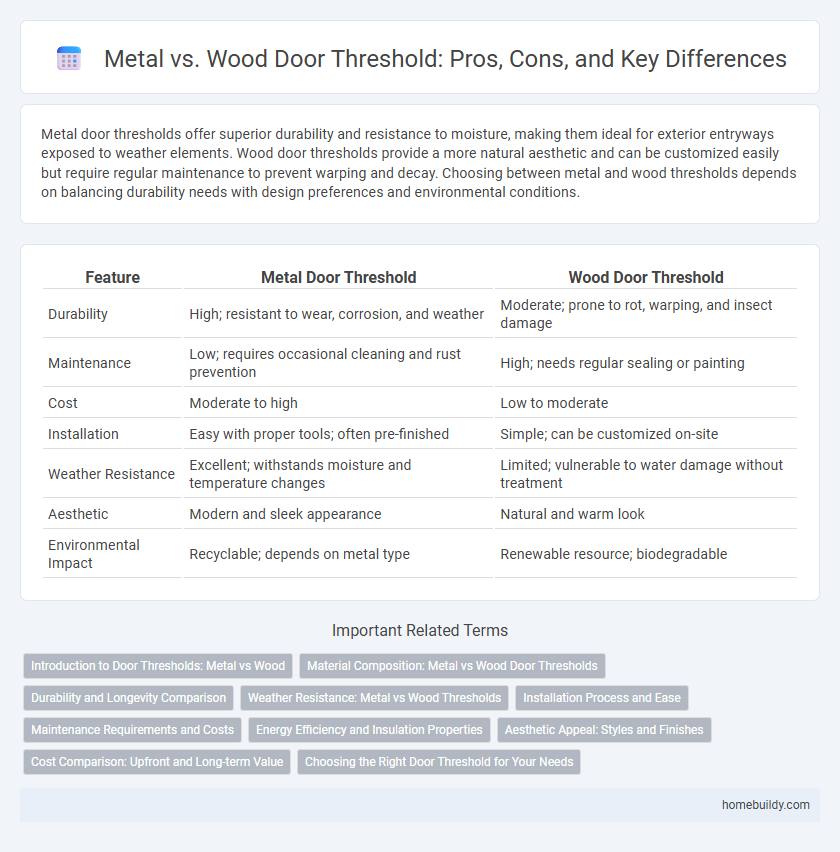Metal door thresholds offer superior durability and resistance to moisture, making them ideal for exterior entryways exposed to weather elements. Wood door thresholds provide a more natural aesthetic and can be customized easily but require regular maintenance to prevent warping and decay. Choosing between metal and wood thresholds depends on balancing durability needs with design preferences and environmental conditions.
Table of Comparison
| Feature | Metal Door Threshold | Wood Door Threshold |
|---|---|---|
| Durability | High; resistant to wear, corrosion, and weather | Moderate; prone to rot, warping, and insect damage |
| Maintenance | Low; requires occasional cleaning and rust prevention | High; needs regular sealing or painting |
| Cost | Moderate to high | Low to moderate |
| Installation | Easy with proper tools; often pre-finished | Simple; can be customized on-site |
| Weather Resistance | Excellent; withstands moisture and temperature changes | Limited; vulnerable to water damage without treatment |
| Aesthetic | Modern and sleek appearance | Natural and warm look |
| Environmental Impact | Recyclable; depends on metal type | Renewable resource; biodegradable |
Introduction to Door Thresholds: Metal vs Wood
Metal door thresholds offer superior durability, resistance to weather and wear, and enhanced security compared to wood door thresholds. Wood thresholds provide aesthetic warmth and natural insulation but require more maintenance and are prone to warping or rotting over time. Choosing between metal and wood door thresholds depends on factors like climate, foot traffic, and desired longevity.
Material Composition: Metal vs Wood Door Thresholds
Metal door thresholds are composed primarily of aluminum, stainless steel, or brass, offering superior durability, resistance to moisture, and low maintenance compared to wood. Wood door thresholds, typically made from hardwoods like oak or mahogany, provide natural insulation and aesthetic warmth but are more susceptible to warping, rotting, and wear in high-traffic or exterior environments. The choice between metal and wood thresholds depends on factors like exposure to weather, desired longevity, and maintenance preferences, with metal being ideal for heavy-duty uses and wood favored for traditional interior styles.
Durability and Longevity Comparison
Metal door thresholds offer superior durability and longevity compared to wood door thresholds due to resistance against moisture, warping, and insect damage. Wood thresholds, while aesthetically pleasing, tend to degrade faster in high-traffic or outdoor environments, requiring more frequent maintenance or replacement. Metal options, often made from aluminum or steel, maintain structural integrity and appearance for decades with minimal upkeep.
Weather Resistance: Metal vs Wood Thresholds
Metal door thresholds offer superior weather resistance compared to wood thresholds due to their non-porous surface and durability against moisture, preventing warping, cracking, and mold growth. Wood thresholds require regular sealing and maintenance to withstand exposure to rain, snow, and humidity, which can deteriorate over time. Choosing metal thresholds enhances long-term protection against severe weather conditions and reduces the need for frequent repairs or replacements.
Installation Process and Ease
Metal door thresholds typically offer a straightforward installation process with pre-drilled holes and durable fasteners, making them easier and quicker to install compared to wood thresholds. Wood thresholds often require precise cutting, sanding, and sealing to prevent moisture damage, which can extend the installation time and require additional tools. The inherent rigidity and standardized dimensions of metal thresholds contribute to a more consistent and less labor-intensive installation experience.
Maintenance Requirements and Costs
Metal door thresholds require minimal maintenance, often needing only occasional cleaning and rust prevention treatments, resulting in lower long-term upkeep costs. Wood door thresholds demand regular sealing, refinishing, and protection from moisture, which increases maintenance frequency and expenses over time. While metal thresholds have a higher initial cost, their durability and reduced maintenance needs provide better cost efficiency compared to wood thresholds.
Energy Efficiency and Insulation Properties
Metal door thresholds offer superior durability but typically conduct heat more readily, which can reduce overall energy efficiency without proper insulation. Wood door thresholds provide natural insulating properties that help maintain indoor temperature by minimizing heat transfer, enhancing energy efficiency. Combining metal thresholds with thermal breaks or insulation materials can improve insulation performance while maintaining strength.
Aesthetic Appeal: Styles and Finishes
Metal door thresholds offer a sleek, modern aesthetic with a variety of finishes such as brushed aluminum, stainless steel, and bronze, providing durability while complementing contemporary designs. Wood door thresholds bring a warm, classic appeal with natural grain patterns and can be stained or painted to match traditional interiors, enhancing rustic or vintage decor. Choosing between metal and wood thresholds ultimately depends on the desired style, finish options, and the architectural context of the space.
Cost Comparison: Upfront and Long-term Value
Metal door thresholds generally have a higher upfront cost than wood thresholds due to durability and material expense, but they offer superior long-term value through better resistance to wear, moisture, and temperature changes. Wood door thresholds are less expensive initially but may require more frequent maintenance, repairs, or replacement over time, increasing overall costs. Considering total lifecycle expenses, metal thresholds provide cost-efficiency for high-traffic or exterior applications, while wood thresholds may suit budget-conscious indoor areas with less exposure.
Choosing the Right Door Threshold for Your Needs
Metal door thresholds offer superior durability and resistance to weather, making them ideal for exterior entrances exposed to heavy traffic and moisture. Wood door thresholds provide a warm aesthetic and can be easily customized to match interior flooring but require regular maintenance to prevent warping and damage. Selecting the right door threshold depends on factors such as environmental exposure, desired longevity, and maintenance preferences to ensure optimal performance and appearance.
metal door threshold vs wood door threshold Infographic

 homebuildy.com
homebuildy.com